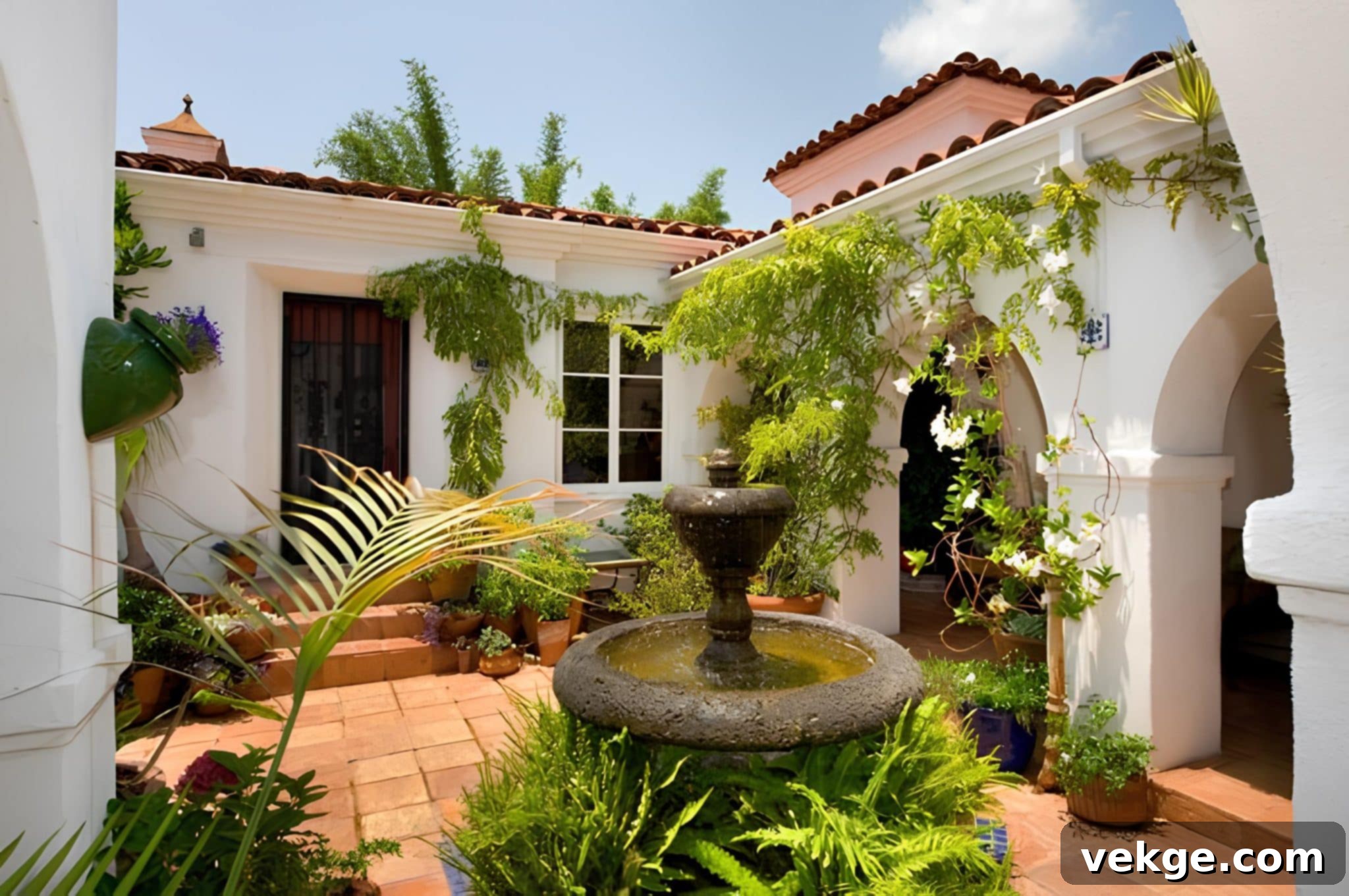Hacienda Style Decor: Infuse Spanish & Mexican Charm into Any Home, Big or Small
Has the captivating charm of Hacienda-style home decor graced your social media feeds lately? Are you utterly mesmerized by the rich, earthy tones, the antique allure, the inviting warmth of red clay roofs, and the pristine elegance of white stucco walls? If these images have sparked a desire to transform your living space, then now is the perfect moment to consider recreating that enchanting Hacienda aesthetic within your own home, no matter its size.
At its heart, a Hacienda-style home draws deep inspiration from the magic and historical grandeur of Spanish architecture. It’s a design philosophy that evokes a sense of romance and timelessness. The characteristic rusty red roofs, the graceful archways, and the crisp white walls work in harmony to transport any dwelling into a picturesque Spanish retreat. This distinctive style is more than just decor; it’s an experience, a blend of history, functionality, and aesthetic beauty.
But a common question arises: can these grand, expansive designs truly be adapted for the cozier apartments and smaller houses prevalent in modern America? The answer is a resounding yes! Today, we will meticulously decode the fundamental elements of Hacienda-style decor and uncover ingenious ways to incorporate its undeniable magic and historical resonance into even the most compact of living spaces. Get ready to embark on a journey that merges tradition with contemporary living, proving that true style knows no size limitations.
Let’s begin exploring how to bring this beautiful style to life!
The Rich History and Enduring Legacy of Hacienda-Style Homes

The story of Hacienda-style homes in the Americas is deeply intertwined with the arrival of Spanish immigrants during the era of Spanish colonization. These early settlers brought with them not just their culture and language, but also their architectural traditions, which were perfectly suited to the bright, warm, and often sunny climates of Spain and Mexico.
Their initial homes were ingeniously constructed from readily available local materials like adobe (sun-dried earth bricks) and clay. These materials were chosen not only for their accessibility but also for their remarkable ability to maintain a comfortably cool temperature indoors, offering a natural respite from the intense heat outside. The iconic white-washed stucco walls and distinctive rounded red roofs were more than just aesthetic choices; they further enhanced this cooling effect, reflecting sunlight and providing excellent insulation. This functional elegance was a hallmark of Spanish Colonial architecture.
In their original context, large open courtyards and grand archways were often tell-tale signs of prosperity and wealth. Historically, luxurious Hacienda-style homes were vast country estates, predominantly owned by affluent Spanish families. These properties served as working farms or ranches, and their architectural grandeur reflected the status of their owners. Over time, as these beautiful and functional homes gained widespread popularity, their core design elements began to transcend their original aristocratic context. Slowly but surely, the captivating features of Hacienda homes were adopted and adapted into more modern American buildings, evolving into the beloved architectural style we recognize today, often referred to as Spanish Colonial Revival or Mediterranean Revival.
Ingenious Ways to Incorporate Hacienda Decor into Small Spaces
Many homeowners might initially feel daunted by the prospect of integrating the typically grand Hacienda style into a smaller space. However, the key lies in understanding the core features and then creatively adapting them to fit your home’s unique dimensions. With a bit of ingenuity and a clear understanding of the design principles, you can infuse your home or apartment with a truly authentic slice of Spain or Mexico.
Let’s explore how to achieve this captivating transformation:
1. Crafting Cozy Courtyards for Intimate Retreats
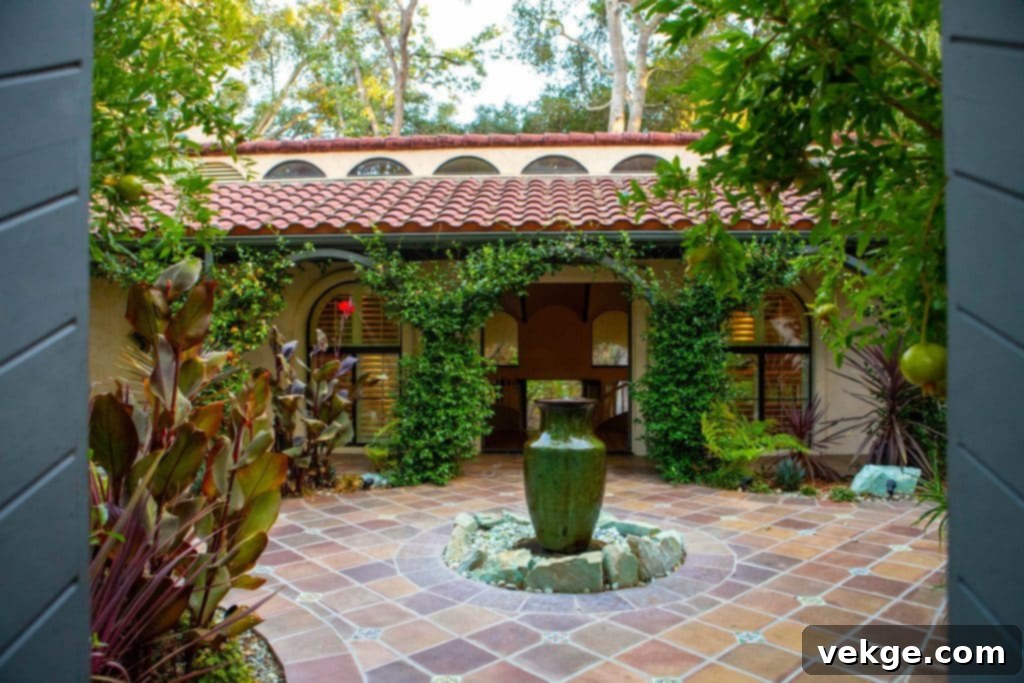
Courtyards are undeniably one of the most defining and enchanting elements of traditional Hacienda homes. Historically, these open-air spaces were strategically located in the center of the estate, serving multiple practical purposes. They provided easy access to various parts of the house, facilitated outdoor cooking, and, crucially, allowed heat to escape directly from the interior, contributing to the cooling of the home. They were also vital social hubs and private oases.
For smaller spaces where a central, sprawling courtyard might not be architecturally feasible, the concept can be beautifully reinterpreted. Instead of a grand central patio, consider creating a more intimate version at the rear of the house, or even a thoughtfully designed side patio or a spacious balcony. The goal is to cultivate a small, cozy courtyard aesthetic. Achieve this by incorporating low, comfortable seating – think built-in benches with colorful cushions or traditional wooden chairs. Abundant greenery is essential; fill the space with a variety of potted plants, succulents, and climbing vines to add lushness and life. A modern, compact fountain can introduce the soothing sound of water, instantly enhancing the tranquil, traditional Spanish ambiance. Even a small water feature can evoke a sense of grandeur and peace, successfully resembling the spirit of traditional Spanish architecture.
2. Embracing the Timeless Beauty of Red Clay Roofing
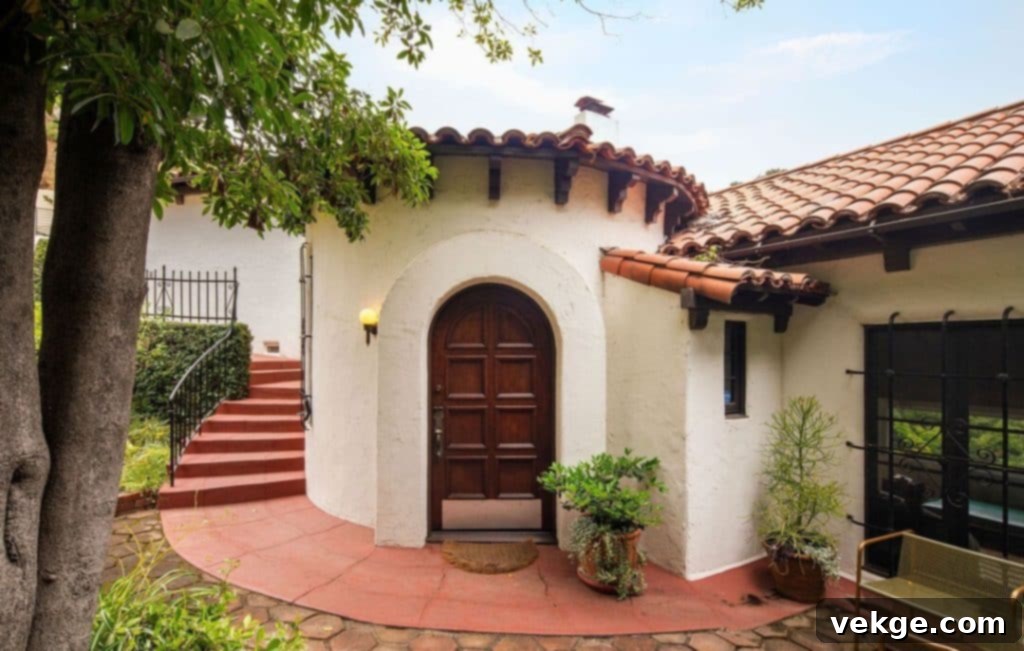
The distinctive, rich red clay roofs are arguably one of the most iconic and recognizable features of Spanish and Mexican homes. What many might not realize is that these beautiful half-tube-style tiles were traditionally handmade, meticulously crafted and then fired to achieve their characteristic earthy hues. Beyond their undeniable aesthetic appeal, these clay tiles are exceptional natural insulators. Their unique curved shape is not merely decorative; it’s ingeniously designed to capture cool air, creating an insulating layer that helps keep interiors significantly cooler, providing essential relief from scorching outside temperatures. This blend of beauty and practicality is a testament to the timeless wisdom of traditional architecture.
It’s truly spectacular to witness how these traditional ideas of luxuriant, climate-adapted living continue to captivate and inspire modern design. For contemporary small houses, incorporating these red clay tiles can instantly recreate the authentic Hacienda aesthetic. If a full roof replacement isn’t feasible, consider decorative elements such as clay-tiled awnings over windows or doors, or even using smaller clay tiles in outdoor kitchen areas or garden pathways to evoke the same warm, rustic charm. The warm, inviting color adds a vital element to the overall Hacienda palette, grounding the home in a sense of history and natural beauty.
3. The Purity and Practicality of White-Washed Stucco Walls
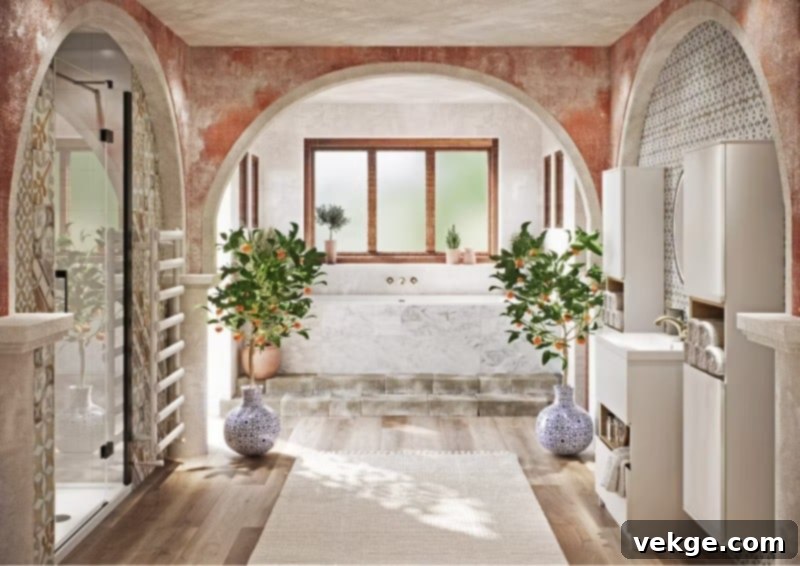
White stucco walls stand as the third foundational element in designing authentic Hacienda-style homes, and their prevalence is rooted in both aesthetics and practicality. The brilliant white paint serves as an excellent reflector of intense sunlight, preventing the walls from absorbing and trapping excessive heat. This was a critical design feature in hot climates, contributing significantly to the thermal comfort of the interiors. Furthermore, in historical contexts, adobe was a widely available and cost-effective raw material for constructing walls, offering robust and naturally insulating properties.
Thus, the combination of a durable adobe or masonry base rendered with a pristine white stucco finish resulted in homes that not only appeared brighter and more expansive but also actively maintained cooler indoor temperatures. These architectural elements of Hacienda homes were undoubtedly essential for comfortable living in their original environments. For small spaces, the reflective quality of white stucco (or white-painted walls indoors) can dramatically enhance natural light, making rooms feel larger and airier. The texture of stucco itself also adds a layer of depth and authenticity, even on interior feature walls, bringing the essence of Hacienda charm inside.
4. Infusing Warmth with Woody and Earthy Accents

While the expansive white walls are a signature feature, they can sometimes risk making a Hacienda home feel somewhat uninviting or even monotonous if not balanced thoughtfully. This is where the strategic incorporation of woody and warm accents becomes absolutely crucial, providing a vital counterpoint that adds depth, character, and comfort to both large and small spaces. These elements introduce a sense of groundedness and organic beauty.
To maintain the traditional Hacienda style, even in smaller homes, emphasize rich, dark wood. Think of robust wooden doors, window frames that stand out, and the rustic charm of exposed ceiling beams. For modern homeowners, if structural exposed beams aren’t an option, decorative faux beams can be installed to achieve a similar visual effect without major renovation. Incorporate these woody elements in hallways, open-plan living areas, or even in a thoughtfully designed cozy courtyard. This deliberate contrast of dark wood against pristine white walls creates a dynamic visual play, adding warmth and sophistication. Further enhance this effect with hand-carved wooden furniture, wrought iron details in light fixtures or railings, and natural fiber textiles like woven rugs or linen curtains. These accents collectively contribute to the inviting, rustic elegance that is central to the Hacienda aesthetic, preventing the space from feeling too stark or cold.
5. The Graceful Allure of Archways and Round Doors
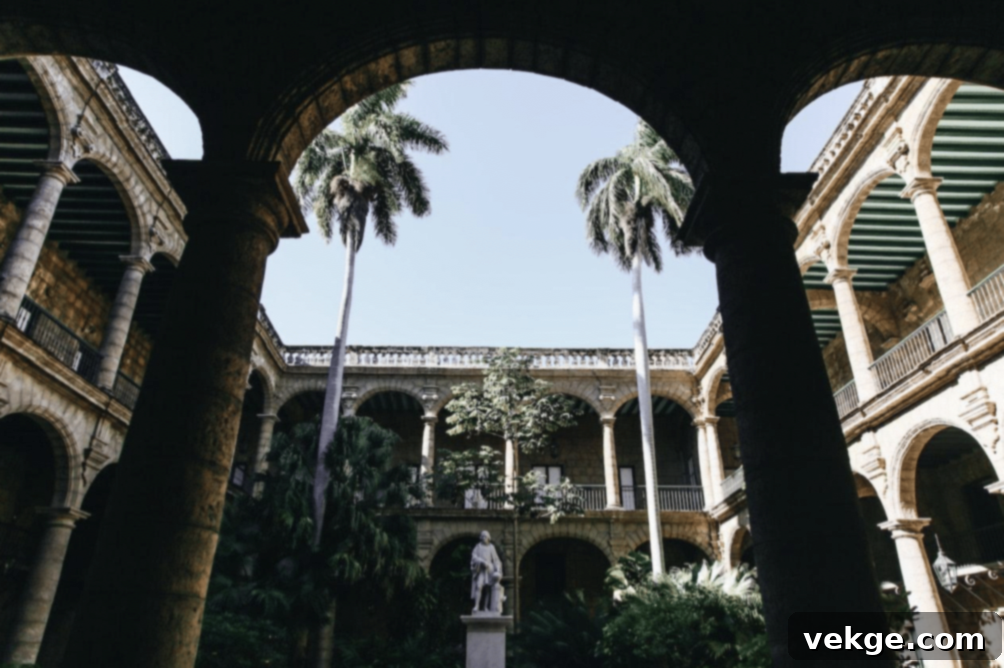
Among the most striking and beautiful features of Hacienda homes are their elegant archways and distinctive round doors. These architectural designs are instantly recognizable and truly set traditional Spanish architecture apart from almost every other style. The sweeping curves of large archways and the inviting softness of round doors bestow a sense of royalty, luxury, and timeless elegance upon home designs, imbuing them with a unique and traditional character that is both grand and welcoming.
The question for small spaces then becomes: how can we achieve this grandeur on a more compact scale? The solution lies in thoughtful adaptation. While you might not have the expansive halls for monumental arches, you can certainly incorporate smaller, yet equally impactful, versions. Consider creating subtle archways between rooms, perhaps an arched opening leading into a dining area or a kitchen. Decorative archway details can be added to existing rectangular doorways or even as architectural features on a wall. Round hallway doors, arched balcony openings, or even small, decorative rooftop domes (if architectural conditions permit) are excellent ways to integrate these iconic shapes. Even features like arched mirrors or built-in arched display niches can evoke the same traditional feel, proving that these design elements can be scaled down effectively without losing their essence or charm.
6. Strategic Placement and Design of Windows
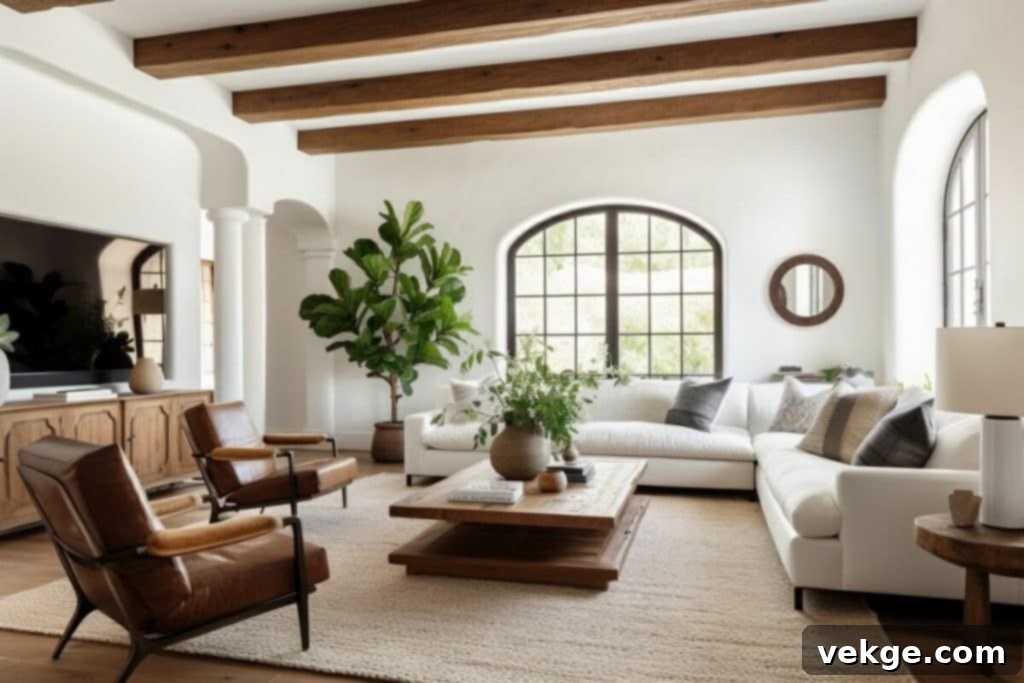
Historically, Hacienda homes were designed with relatively small, often wooden windows, a deliberate choice made in response to the hot, sunny climates of Mexico and the American Southwest. The primary objective was to allow sufficient natural light to illuminate the interiors without letting in excessive heat. Coupled with the insulating properties of thick adobe or stucco walls, these smaller windows played a crucial role in maintaining a comfortable and cool indoor temperature, providing a shaded sanctuary from the outside sun.
However, modern living in smaller spaces, often equipped with efficient air conditioning, offers more flexibility. While you can certainly embrace the traditional small window look for authenticity, contemporary adaptations allow for larger windows to maximize natural light and views, particularly beneficial in compact rooms that can feel enclosed. To maintain the Hacienda aesthetic while opting for larger windows, consider adding decorative wrought iron grilles or intricate wooden shutters on the exterior. Inside, heavy, flowing drapes in natural fabrics can be used to control light and provide a sense of grandeur, echoing the historical purpose of climate control while balancing the demand for more natural light in smaller, modern settings. This thoughtful recreation strikes a perfect balance in light management while incorporating more of the adaptable Hacienda style.
Modern Day Hacienda Homes in America: Inspiration All Around

If you’re still finding it challenging to fully visualize Hacienda-style decor for your specific small space, drawing inspiration from real-life homes can be incredibly helpful. Across America, particularly in regions that share similar climates and historical Spanish influence, you’ll find a wealth of examples. Warmer states like Arizona, Florida, New Mexico, and parts of California are rich with homes that have beautifully adapted and maintained this architectural style. These regions offer fantastic opportunities to witness how Hacienda elements are integrated into diverse settings, from sprawling estates to more compact suburban homes and even urban townhouses.
Planning your next vacation to one of these sun-drenched regions could double as an inspiring research trip! Imagine strolling through historic districts in Santa Fe, New Mexico, or exploring charming neighborhoods in St. Augustine, Florida. You’ll gain a real-time perspective on how Hacienda aesthetics, both subtle and overt, contribute to the unique character of a home. Pay attention to the use of materials, the interplay of light and shadow, and the way outdoor spaces are designed to complement the interiors. This firsthand experience can ignite your imagination and provide concrete ideas for how to bring the warmth and beauty of Hacienda style into your own home, no matter its size.
Summing It Up: Your Journey to Hacienda Charm
In conclusion, embracing Hacienda-style decor in smaller spaces is not only possible but also a delightful journey into rich cultural aesthetics. Your transformation can begin with a deeper understanding of the history behind this traditional Spanish and Mexican architecture. Delving into its origins will reveal the remarkable intelligence and thoughtful design principles that shaped these romantic and enduring houses, particularly their ingenious adaptation to warm climates.
While the traditional Hacienda often featured grand archways, expansive round doors, and sprawling courtyards that might seem to demand significant space, modern living and innovative experimental decor have paved the way for successfully incorporating Hacienda elements into even the most compact contemporary homes. The beauty of this style lies in its adaptability and the ability to capture its essence through key features.
For those embarking on this design adventure, we highly recommend starting with foundational and easily implementable elements. Begin with the crisp, light-reflecting white stucco (or painted) walls, which instantly brighten and expand a small room. Pair this with the warm, rustic appeal of red clay rooftops – whether on a full roof, a porch awning, or even as decorative accents. These ‘baby steps’ will immediately set the tone and character of your Hacienda-inspired home.
How will you choose to infuse the timeless charm of Hacienda style into your small rooms? We invite you to share your ideas and experiences. Comment below and let us know your favorite ways to incorporate this beautiful, historic aesthetic!
